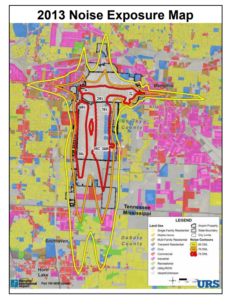 Q: What makes a jet loud?
Q: What makes a jet loud?
Airplane noise is comprised of both engine noise and airframe noise. Engine noise, which is typically most pronounced during takeoff, has several contributors. The turbulent mixing of flow streams—when the hot core efflux (high-velocity exhaust) and the fan exhaust flow meet free-streaming air—produces noise from the engine’s jets. The fan within the engine makes noise that escapes from both the front and back of the engine. The fan is also responsible for the “buzz saw” noise during takeoff, created when the tips of the fan blades are traveling close to the speed of sound.
Airframe noise, unlike engine noise, is most noticeable during landing. The lowering of landing gear creates turbulence that produces noise. Similarly, the interaction of flaps and slats on the wing during descent influences airstream flow and thus creates noise.
Q: Why do some aircraft seem louder than others?
Aircraft operating at MEM have a diverse range of noise levels. These noise levels primarily depend on the type of engine used by the aircraft, the size of the aircraft and whether the aircraft is taxiing on the airfield, landing or taking off. Departures tend to be louder than arrivals since the pilot is forcing more power to the engine to achieve lift.
Q: Why do planes fly over my house?
There are several airports in the Memphis metropolitan area: Memphis International Airport, DeWitt Spain General Aviation Airport, Charles Baker General Aviation Airport and other public and private airports. The FAA regulates and classifies airspace throughout Memphis to separate air traffic both horizontally and vertically. It is inevitable that air traffic will occur over all areas of Memphis, however, overflights may occur more frequently if you reside closer to an airport’s flight pattern.
Q: Who tells airplanes where to fly?
The Federal Aviation Administration (FAA) is the sole organization in the US responsible for the movement of aircraft both on the ground and in the air. All air traffic controllers work for the FAA as part of one national airspace system.
The FAA is also responsible for designing air travel routes and procedures, including the standards for lateral and vertical separation between aircraft and determining hazards to flight such as mountains, towers, or tall buildings. An airport may advocate for certain noise abatement flight tracks to reduce noise, but these must be both approved and assigned by the FAA.
Q: Which flight path impacts me?
Aircraft associated with MEM tend to fly within broad airspace corridors as the FAA directs aircraft to and from the airfield. If you live within one of these corridors, you will likely experience aircraft over-flights, however, other land areas not under the flight tracks can be impacted. How and to what frequency any particular land area is impacted depends on factors such as the weather, the runway end being used, the type of aircraft, aircraft engine characteristics and relative distance from the airport. The Memphis-Shelby County Airport Authority (MSCAA) can assist you to better understand this relationship between where you live and aircraft over-flights.
Q: What are the rules regarding how low an aircraft can fly over a residential area?
Aircraft altitude is established by Federal law. Title 14, Code of Federal Regulations, Section 91.119 (which governs flight) states:
• “Except when necessary for takeoff or landing, no person may operate an aircraft below the following altitude:
o Over any congested area of a city, town or settlement, or over any open-air assembly of persons, an altitude of 1,000 feet above the highest obstacle within a horizontal radius of 2,000 feet of the aircraft.”
It is important to be aware of two aspects of this regulation. First, most aircraft operating in the vicinity of MEM are in the process of landing or taking off, thus, this regulation does not apply. Second, helicopters are specifically exempted from this Federal Regulation.
Q: How does weather affect aircraft noise?
In IMC (Instrument Meteorological Conditions) the visibility and cloud cover are low enough that an airplane must fly to an airport via on-board instruments along a route identified on a published instrument approach procedure. The aircraft will fly at the MDA (Minimum Decent Altitude) to a point at which it has visual contact with the runway and safely lands or must fly the missed approach procedure because visual contact with the runway was not made and a safe landing is not possible. In IMC conditions the aircraft noise is amplified due to the cloud cover containing the noise near the ground. In aviation, safety is always of utmost importance first and in IMC conditions, an increased level of noise should be anticipated.
Q: Why doesn’t the airport prohibit nighttime flights?
Due to Federal legislation, the Airport Noise & Capacity Act of 1990(ANCA), U.S. certificated airports are restricted from instituting bans on commercial aircraft operations.
Q: How are noise levels determined?
To more consistently and easily describe and compare noise environment comprised of numerous single events that vary in duration and magnitude over extended periods of time, the U.S. Environmental Protection Agency developed a single number descriptor. This descriptor is the DNL. It is a noise metric which describes an average day/night sound level.
The FAA uses the DNL metric to quantify aircraft noise exposure in the vicinity of an airport. Noise contours of specific DNL levels are developed using the FAA’s Integrated Noise Model (INM). Airport specific data used in the INM model to develop the contour will result in the depiction of noise exposure in the vicinity of an airport. Airport specific data used in the INM include: Average Daily Operations, Aircraft Fleet Mix, Runway Use, Flight Corridors and Usage, Departure Destinations and Day/Night Use.
Q: What are noise contours?
Noise contours are a series of lines superimposed on a map of the airport’s environs. These lines represent various DNL levels (typically 65, 70, and 75 dBA). DNL noise contours are used for several purposes.
- Noise contours highlight existing or potential areas of significant aircraft noise exposure (as defined by the FAA).
- Noise contours are used to assess the relative aircraft noise exposure levels of different runway and/or flight corridor alternatives.
- Noise contours provide guidance to political jurisdictions in the development of land use control measures. These measures include zoning ordinances, subdivision regulations, building codes, and airport overlay zones.
It is the areas within the 65, 70, and 75 DNL noise contours that the FAA considers to be the most impacted by aircraft generated noise.
Q: What do complaints represent to the airport?
We take the concerns of all community members affected by our operations seriously. We take a balanced approached when assessing any noise mitigation initiatives. The complaints help us understand what impacts our airport operations are having on the community and help us:
- gauge level of concern over a specific procedure or operation;
- determine where to focus our community outreach;
- check that procedures are being followed and there is no deviation from noise abatement procedures;
- identify trends or irregularities that may need to be investigated or assessed;
- assess results of trials;
- communicate with the community about our operations, provide accurate information (address myths/rumors or inaccurate information);
- inform elected officials about community concerns; and
- assess future impacts of our growth.
How will my complaint be dealt with?
Memphis International Airport understands that aircraft noise can have an effect on our surrounding communities. Every complaint we receive is:
- Analyzed
- Registered
- Responded to upon request
We analyze complaints by comparing the date and time of the complaint with our Flight Tracking System records to determine what may have caused the issue and how Memphis International Airport can learn from this occurrence.
